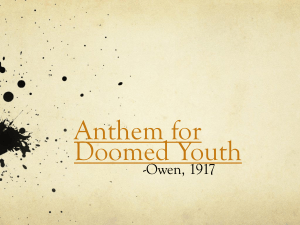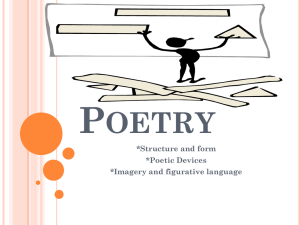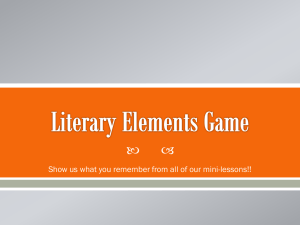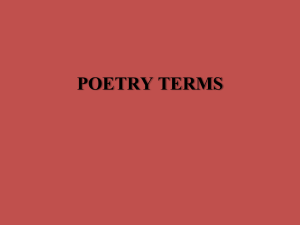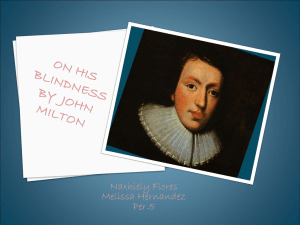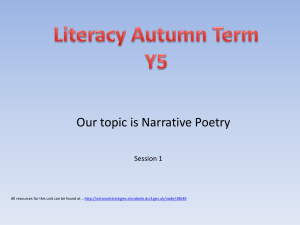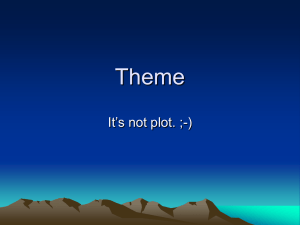Poetry Unit Slideshow
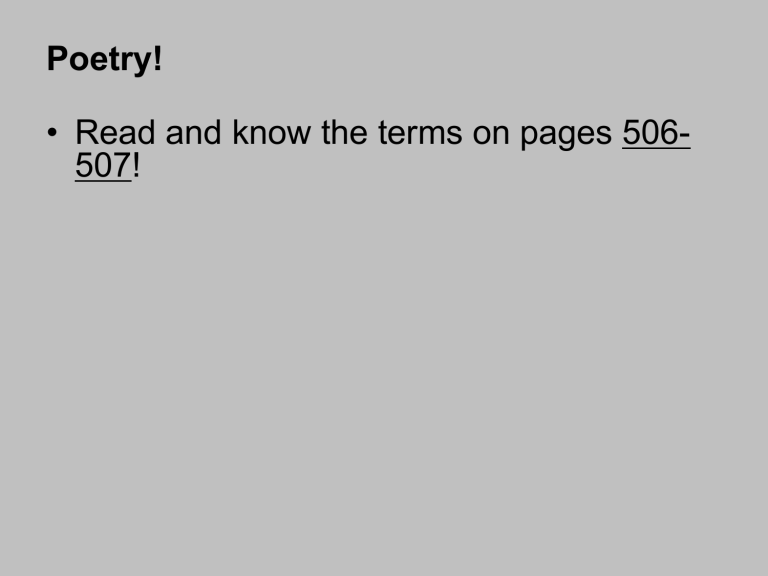
Poetry!
• Read and know the terms on pages 506-
507!
“Sarah Cynthia
Sylvia Stout
Would Not Take
The Garbage Out ”
~Shel Silverstein
Forms:
•Narrative Poem: a poem that tells a story with a plot and characters
•Couplets: pairs of rhyming lines (“Stout” / “out”)
•Alliteration: repetition of consonant sounds at the beginning of words
– Examples: The title and lines 15, 19, 24, 29
•Hyperbole: exaggeration to emphasize a point
– Example: “At last the garbage reached so high / that finally it touched the sky.
” (Lines 33-34)
Content:
• Rhyme & Alliteration: gives the poem a song-like, humorous, childish, fairytale, bedtime-story mood
• Hyperbole & Humor: Emphasizes the problem but keeps the mood light
• End: Bedtime story told by a parent / narrator!
• Message:
– Literal: Take the garbage out!
– Symbolic :
– Don’t procrastinate!
– Take care of the environment!
“The Highwayman”
Forms
~ Alfred Noyes
•Narrative Poem
•Setting: Dark and stormy night
– Mood: eerie; suspenseful; scary
•Metaphor: comparison
– Line 3: “The moon is a ghastly galleon…”
•Simile: comparison using “like” or “as”
– Line 24: “Dumb as a dog he listened…”
•Stanza Rhyme Scheme: AABCCB
•Onomatopoeia: words that resemble sounds
• “Tlot-tlot; tlot-tlot!” for the horse’s hooves (Line 68)
•Sensory Images
1.Sight
2.Sound
3.Touch
“The
Highwayman ”
~ Alfred Noyes
Content:
•Inference: Tim the ostler, or stable-worker, probably told on
Bess and the highwayman.
•Bess’s plan is suspenseful because only her actions, not her thoughts, are given.
•Themes: Romance; Love; Betrayal; Sacrifice
•Repetition at the End: Suggests that Bess and the highwayman ’s love continues after their deaths!
“The Cremation of Sam McGee ”
~ Robert Service
Questions:
1.Canada
’s Yukon Territory on the Arctic Trails leading to
Lake Lebarge.
2.It will be a strange, creepy tale. (It will “make your blood run cold.
”)
3.He was kept there by his lust for gold.
4.Personification. It means they were twinkling.
5.Simile: “It stabbed like a driven nail.” It means that it was bitterly cold.
6.The setting of the cold causes Sam ’s death and leads to his desire to be cremated.
“How I Learned
English ”
~ Gregory Djanikian
Questions:
1.An empty lot surrounded by trees and cirrus clouds during a baseball game in Williamsport, PA.
2.He has just immigrated and does not understand English, baseball, or American culture.
3.He was writhing (1) in pain and everyone else was writhing (2) in laughter.
4.He is “stung” by Joe’s ball and yells, “My shin!”
5.The speaker laughs and feels accepted which leads him to learn baseball and English.
“Stopping by
Woods on a
Snowy Evening ”
~ Robert Frost
(Pages 608-9)
Forms:
•Lyric Poem: expresses the thoughts and feelings of a single speaker, often in a musical way
•Rhyme Scheme: AABA BBCB CCDC DDDD
•Repetition: repeated sounds, words, or phrases
– Examples: Lines 15-16
•Meter: rhythmical pattern in a poem
•Iambic (unstressed, stressed) Tetrameter (four “feet” per line)
• Example: Whose WOODS | these ARE | I THINK | I KNOW
Content of Stanzas
1.A man stops in the woods to watch someone else ’s land fill with snow.
2.The man wonders what his horse thinks about why they are not stopping at a house.
3.The horse shakes his bells and the only other sounds are wind and snow falling.
4.The speaker enjoys gazing at the snowy woods, but he has promises and a journey he knows he must still take.
Messages
• Literal:
– The man cannot daydream and watch the snow because he has work to do.
• Symbolic:
– Balancing work and play is hard.
– You can’t stop too long “to smell the roses.”
Worksheet One
“Loo-Wit” by Wendy Rose
1. Ash
2. The “old woman” is a symbol for the volcano.
3. Lines 8, 14-15, and 16
4. She
“crouches,” “sleeps,” and “sings.”
5. Simile
6. Her “weapons” are lava, ashes, rocks, etc. Her “singing” is the sound of the eruption.
7. Summarize the poem.
“Life” by Naomi Louise Madgett
8. “Life” is “a toy that swings on a bright gold chain.”
9. The “toy” “swings,” “ticks,” and is “bright” and “gold.” Children are attracted to movement and bright, shiny objects.
10. The keeper is “tired” and stops the game.
11. Imitation poems.
Worksheet Two
“Seal” by William Jay Smith
1. A Concrete Poem ’s shape suggests its content. This poem is shaped like its subject —a swimming seal.
2. Lines 11-12, 13, 14
3. Rhyme (zoom / room); Repetition ( “See how he…”); Onomatopoeia
( “a whoop, a bark”)
4. “See how he…” and “Past…”
5. No regular rhyme or meter.
“Fog” by Carl Sandburg
1.Metaphor; the fog is silent and lingers like a crouching cat.
2.Sight ( “cat feet” and “looking”) and Sound (“silent”)
3.Imitation Poems
“Annabel Lee”
~Edgar Allen Poe
(Pages 598-9)
Forms:
• Narrative Poem
– Ballad: songlike poem that tells a story of adventure/romance
• Rhyme and Repetition: The rhyme and repetition gives the story an oppressive, fateful atmosphere.
Content
• Setting: many years ago in a kingdom by the sea
– Fantasy Setting
• Stanza 1: Speaker and Annabel Lee are lovers.
• Stanza 2 - 3: Angels envy their love and send a chilling wind to kill Annabel Lee. Her rich family takes her body and places it in a tomb.
• Stanza 4 - 5: The speaker says nothing can keep their souls apart.
• Stanza 6: The speaker goes nightly to sleep by her tomb out of devotion.
“The Village
Blacksmith ”
~ Henry
Wadsworth
Longfellow
(Pages 544-546)
Forms:
• Lyric Poem: More description than story!
• Some rhyme throughout
Content ~ The Blacksmith ’s Characterization…
•Mighty
•“Sinewy hands”
•Brawny arms “as strong as iron bands” (simile)
•Crisp, black, long hair
•Brow “ wet with honest sweat ” (internal rhyme)
•Earns his work honestly and attends church faithfully
•His wife died, but his daughter reminds him of her.
•“Hard, rough hand” wipes a tear from his eye.
– He is tough and tender.
•The blacksmith has learned the rhythms of life: “Toiling— rejoicing —sorrowing”
•He works on a new task each day and earns his sleep.
– Ecclesiastes 5:12
•The speaker thanks the blacksmith for his example.
• Speaker’s Tone: admiring; grateful; respectful; etc.
•Represents: A hard-working, ideal man / citizen
•
Message in the Last Stanza:
–Metaphor in lines 45-48
–Our destiny is made (“wrought”) in the struggles and decisions of life
( “the flaming forge”) that shapes our character ( “each burning deed and thought ”).
–Read James 1:2-5.
–
http://www.youtube.com/watch?v= myBPSyyNa4k
“Miracles”
~ Walt Whitman
(619-21)
• Form:
– Free Verse: no regular rhyme or meter
– Lyric Poem
– Only 5 sentences!
Content:
•Begins and ends with
Rhetorical Questions
• Q: “Why, who makes much of a miracle?”
•
Q:
“What stranger miracles are there?
”
• The universe, and everything in it, is contingent, which means that it did not have to be!
• For Whitman, everything is miraculous! ( “I know of nothing but miracles…”)
• Read Psalms 19:1-6!
• 2 Most Particular Sensory Images (or “Miracles”)
1.
“Honeybees busy around the hive of a summer forenoon ” ( VISUAL ; Line 10)
2.
“Exquisite, delicate thin curve of the new moon in spring ” ( VISUAL ; Line 14)
“Surfing at Virginia Beach”
~ by Mr. Chase
Morning I make the pilgrimage: board in hand
I battle the sand to the shoreline, the realm of revisions.
Is this what it means to be alive, to dive into organic bliss, the saltwater hiss?
It ’s at least more alive than the flickers of 7-11s, the heavens, of some copper-faced cult.
For here there is an ebb and flow, the tide below, indifferent to methodic me.
Here gulls join in pulsing chants to this endless romance of circumstance.
MLK
~ Raymond
Patterson
(600)
Form
• Lyric Poem: emphasis on descriptions
• Written in Couplets
• Only 4 sentences long.
MLK
• Content
• MLK is compared to Jesus through Biblical Allusions:
• His love is “deep” and “wide.”
• “Passion” is the word used for Christ’s death.
• He was “slain,” “but he will come again.”
• Ending: His followers will carry on his cause!
• Give a line-by-line personal translation of the poem in your notes:
He came at a time of trouble — his love caused him to act.
He was determined and refused to surrender.
He taught people in pain that all men are equally valuable.
He was killed for this, but his cause will be carried forward.
“Pride (In the Name of Love)”
by
U2
One man come in the name of love
One man come and go
One come he to justify
One man to overthrow
In the name of love
What more in the name of love
In the name of love
What more in the name of love
One man caught on a barbed wire fence
One man he resist
One man washed on an empty beach.
One man betrayed with a kiss
In the name of love
What more in the name of love
In the name of love
What more in the name of love
Early morning, April 4
Shot rings out in the Memphis sky
Free at last, they took your life
They could not take your pride
In the name of love
What more in the name of love
In the name of love
What more in the name of love
In the name of love
What more in the name of love...
“Full Fathom Five”
~ Shakespeare
Questions:
1.Alliteration!
2. (1) His bones become coral. (2) His eyes become pearls.
3. The father is changing into a statue.
4. “Ding-dong.”
“Onomatopoeia”
~ Eve Merriam
Questions:
1.(1) sputters (2) splutters (3) spatters (4) splatters (5) plash
2.(1) “spatters a smattering” (2) “slash spatters” (3) “stops sputtering ”
3.The water flows harder and harder throughout the poem.
“Train Tune”
~ Louise Bogan
Questions:
1.It mimics the “CHUG-a-chug-a” rhythm of a train.
2.Weather, landscapes, time, and love.
3.Love.
“
The Rider
”
~ Naomi Nye
(521)
Form
• Lyric Poem: speaker ’ s thought process
• Written in Free Verse
• The loose form reflects the jumbled way our thought process works.
“
The Rider
”
Content
• Speaker ’ s Thought Process
• A boy said he outruns his loneliness when he rollerskates fast.
• This is the best reason to be a champion!
• I ’ m biking; does it work for biking?
• I want to be a champion so that I can outrun my loneliness and be like a senseless, beautiful flower.
“
Haikus
”
~ Buson
(523)
Form
• Haiku: traditional Japanese form with 5, 7, and 5 syllables
• Haikus focus on nature and create contrasts.
• Examples:
• Haiku 1 = foolish ducklings vs. sneaky weasel
• Haiku 3 = moon vs. shadows

